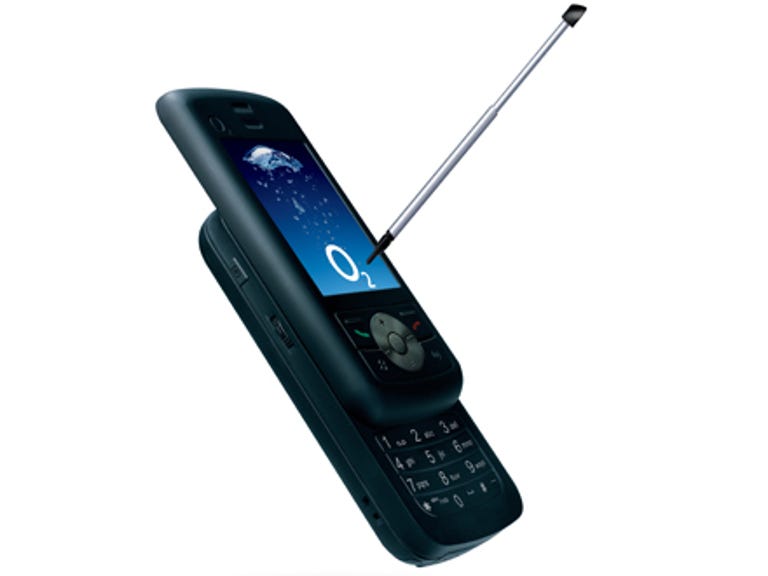 Why You Can Trust CNET
Why You Can Trust CNET O2 Xda Stealth review: O2 Xda Stealth
O2's Xda Stealth looks a lot like a regular slider phone, until you flick it open and notice the Windows Mobile 5.0 operating system, push e-mail capabilities and built-in Wi-Fi support.
Design
If you're going give a product the suffix of "Stealth", then it's fair to expect a few things. It should probably be somewhat undetectable, for a start, although probably not completely invisible. A completely invisible phone would drive you insane, as you'd be able to hear it ringing on your desk but not actually find it, and even if you did, working out which buttons were which would still stymie you. No, instead O2's using "stealth" to presumably point out that the Xda Stealth looks somewhat like a chubby slider phone when powered down, and it's only when you flick the screen on that you realise it's also a fully functional Windows Mobile 5.0 smartphone with the usual touchscreen features. As smartphones go it's on the smaller side at 110 by 53 by 22.5 millimetres and 140 grams, but in a slider world rich with phones like the LG KG800 and Samsung D900, this is still a Kirstie Alley to their Kate Moss slender style.
The Good
The Bad
The Bottom Line
The unslid portion of the Xda Stealth comprises selection buttons, calling buttons, a four way directional pad with a small enter key and, of course, the touchscreen above, which is a 2.4-inch 320x240 display. Underneath the sliding portion sit backlit dialling buttons in standard array. As with most of O2's range, charging is performed via USB, either with a PC cable or the supplied AC charger. The USB socket is located at the bottom of the phone. It took us some time to work out where the Xda Stealth's stylus was located -- perhaps that's the reasoning behind the stealth moniker. It sits in a groove at the base, just next to the USB charger, for what it's worth.
Features
As a phone, the Xda Stealth is a tri-band (GSM900/1800/1900) phone with 192MB of flash ROM and 64MB of RAM, alongside a side-mounted miniSD card slot. Those with a particular phone tech fetish will no doubt care that it's running an Intel XScale processor at 416Mhz. Wireless connectivity runs the gamut of 802.11g (and thus 802.11b by default) as well as Bluetooth. The 2-megapixel camera located on the rear of the Xda Stealth is a nice inclusion, although as it's not a 3G compatible phone, you'll only be using it for happy snaps or the odd bit of grainy video shooting.
On the smartphone front, the Xda Stealth runs on Windows Mobile 5.0, with capabilities for push e-mail, office document viewing, Web browsing and, of course, playing Bubble Breaker. One nice add-on feature that the Xda Stealth includes is a virtual answering machine, designed to save fees on mobile phone voicemail services. When activated, it'll automatically intercept all incoming calls, play a user-recorded file and then save the calls as Windows Media Audio files, rather than leaving them with your telco. It's a nice software addition that we could see annoying plenty of telcos if the idea spreads.
Performance
On the phone front we only had a few problems with the Xda Stealth. While it in theory offers the option of either touchscreen or dialling pad for calling numbers, we found a few instances -- such as entering SIM security codes -- where it completely ignored the dialling pad. To make matters worse, it gave us no error messages to indicate we should only use the touchscreen, leaving us wondering why we were getting no signal all of a sudden. Battery life wasn't all that exceptional, with the phone requiring recharging every two days during our test period under moderate usage. Expect that figure to dive if you use the integrated wireless or Bluetooth functionality often.
On the Windows Mobile front we were mostly satisfied with the Stealth, but never entirely happy. On the plus side, while its offering of applications isn't that much different from any other smartphone, they all worked reasonably quickly and well. On the minus side, as with other touchscreen specific smartphones, long text entry is still something of a chore. We also quickly found it prudent to keep the Stealth locked at all times, as it had the disconcerting habit of launching applications while it was sitting flat on a desk. Hopefully a future firmware upgrade will fix that particular quirk.
Our biggest concerns with the XDA Stealth were, however, outside of its functions as a phone or PDA, and more centered on the phone's physical design. Once we found the unit's stylus, we were rather disconcerted to discover that the nub of the stylus fell off very easily. Our opinion of the XDA Stealth wasn't improved when it managed this trick while trying to get the stylus out of the phone, whereupon we had to use a pen to wedge the stylus out. This could be a function of our particular review model having been treated badly by other reviewers, but it doesn't bode well for the durability of the unit as a whole. Then there's the display screen. At 2.4 inches (6cm), it's relatively generous by slider phone standards -- but quite small by smartphone standards. When you combine that with the physical size of the Stealth, sitting between the uber-slim sliders and the bigger, chunkier Blackberry-style smartphones, you end up with a phone that's perhaps not quite as easy to use as it should be.


